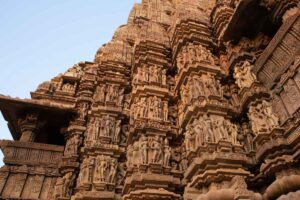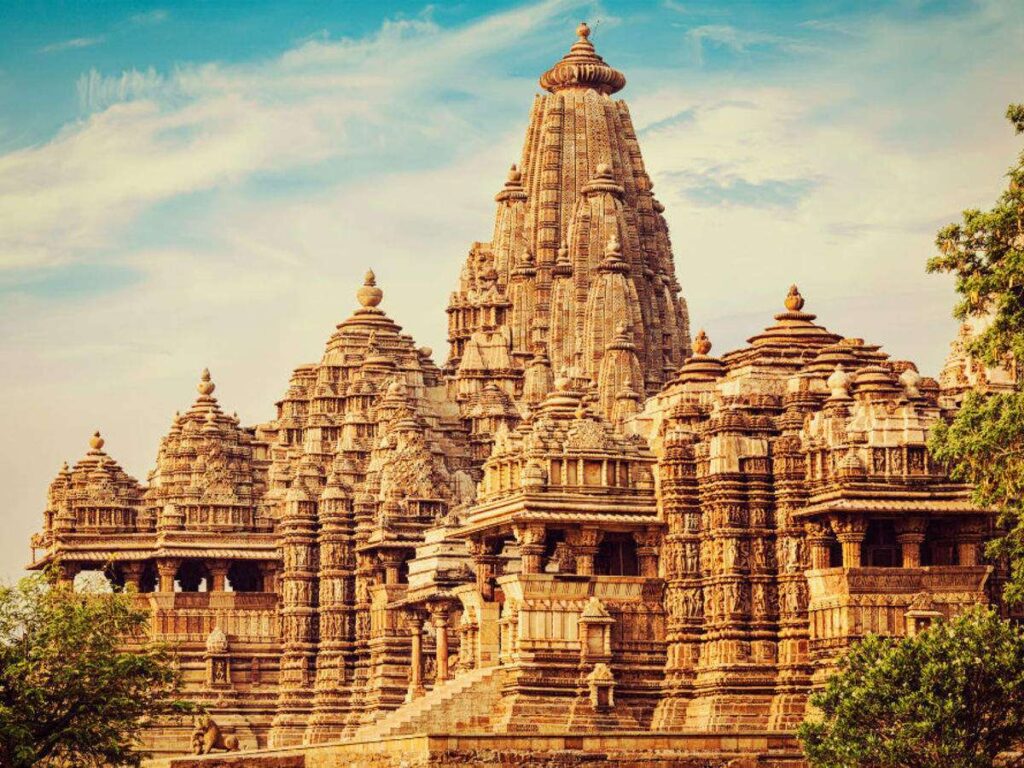Who built Khajuraho temple?
–by Sudha Ganesh
–Reading Time – 10 min Approx
Khajuraho, otherwise known as the temple of love, is one of the most eminent tourist spots in India. These ancient monuments fall under two main categories – the Vedic and Jain temples. Historical records show that in the 12th century, around

85 temples were built but over the years, or more accurately in the 13th century when the mugils captured the nation, most of the temples were destroyed and only 20 temples survived. One of them is the Khajuraho temples situated in Madhya Pradesh, India.
Who Built Khajuraho Temples?
As to the question of who built Khajuraho Temple, the only bit of information known is that it was built during the reign of the Chandela dynasty, between 885 and 1050 AD. The great Vedic kings, Yashovarman and Dhanga take the credits for building most of these beautiful Khajuraho temples. The name Khajuraho was inspired by the word ‘Khajur’ which means date palm. The temples of Khajuraho have two golden date palm trees, hence the name.
Lakshmana temple and Vishvanatha temple are the best and have the unique architecture of the kings respectively. Kandariya Mahadeva temple which was built by king Vidyadhara is one of the largest and currently surviving temples. The inscriptions on the temple suggest that almost all the currently surviving temples were built between 970 AD and 1030 AD.
The story of the sculptures:
The story goes that there was a beautiful woman named Hemavathy. Once she happened to take a bath in the dark. Hemavati was indeed so beautiful that the Moon God fell in love with her and captured her. They soon give birth to a son and name him Chandravarman. However, Hemavathy was furious because the child was born before the wedding and cursed the Moon God. The Moon God later prophesied that the child would grow up and become a king. Thus Chandravarman became the king of the Chandela dynasty. His mother, Hemavathy, had appeared in a dream and asked him to build a temple that would represent human emotions. This is the story behind the creation of the Khajuraho temples.
The Khajuraho temple sculpture explanation states that these sculptures the purpose of sex education. In ancient times, once the young men completed Gurukulas and were ready to enter their next phase of life, they were brought here to understand sexual life. Also, since during that period Buddhism played a major role in many parts of the country, it is said that people were losing interest in sexual life and these temples were built to rekindle sexual activity.
Some also say that before entering the temple one has to leave behind lust and desire, to respect the fact that the carvings of sexual sculptures are only outside the walls and are not inside the temple. Some even believe that the sculptures are a union of Lord Shiva and Parvathi.
These interpretations about the Khajuraho temple sculpture make it more interesting for the tourists who come to visit these temples. They joyfully listen to all the stories while enjoying the renowned Khajuraho Temple architecture.
Sculptures apart from sexual carvings:
These temples have beautiful sculptures apart from the erotic carvings as well. They are divided into 3 main categories – western, eastern and southern. The temples located in the west have most of the erotic carvings while the other two regions have other sculptures. Furthermore, they are broadly classified into five major categories.
The first category is called the ‘Shilpahastra’, some of them are seen in the Jain museum as Tirthankaras. The second categories are the sculptors of attendants, the guardians, and Gandharvas, and so on.
The third category is referred to as ‘Sapna Sundharies’. These sculptors look like real figures. They are very realistic and are carved with a lot of details. These are the sculptures of women engaged in various activities such as painting, dancing, holding a parrot, caressing a baby, and many more.
The fourth category shows the sculptures of men and women doing their day-to-day activities, such as warriors, dancers, musicians, teachers, and students, a scene from the royal court, a scene from the funeral, mythological animals, and embedded carvings.
The fifth and final category is the famous erotic sculptures. These sculptures depict various sexual activities such as group sex, and a scene of unnatural sex.
These sculptures showcase the power of the sculptors who have given life to these carvings with their natural talent of sculpting.
The controversies of Khajuraho:
This monument has witnessed various responses from the tourists who come to visit the temples. Looking at the erotic sculptures, people give a mixed reaction. Some people giggle, some feel shy or embarrassed, some even look away. Despite of all those varied reactions, there is no doubt that people get astonished witnessing the beauty of these unique sculptures.
These temples help us understand the value of the Chandela culture that flourished in the 12th century. If not for these temples, we would have forgotten the Chandelas.

The authenticity of the temple:
The monument is super authentic in terms of its locality, architecture, and materials used. The temples are built with sandstone in a picturesque landscape of an area of 6 square km. and all these temples are elevated. Towers are built on the top and are called the ‘Shikhara’. The well-planned and executed structure stands tall even now and exposes the charming vision of the Chandela culture and their love for art.
The entrance of the temple leads to the main hall, through which you reach the ‘Antarala’ and then the sanctum. The main hall has large windows and a circular path around the sanctum. The sculptures show all the fame of the Khajuraho Temple which was designed aesthetically by the craftsmen. Even after so many years, these sculptures are still considered to be one of the best art forms tol date.
Conclusion:
Khajuraho group of temples is owned by the Government of India and managed by the Archaeological Survey of India. The Archaeological Survey of India maintains and facilitates the allocation for the maintenance of the monuments. The site is annually inspected and assessments are carried out to guard this exotic treasure safely. The experts from various departments work together in maintaining the property.
However, this historical monument needs special attention and care. Constant monitoring and assessment are required to protect and safeguard the world’s most popular Khajuraho temples. After all, this is one of our greatest pride and treasure of our nation.
–by Sudha Ganesh


